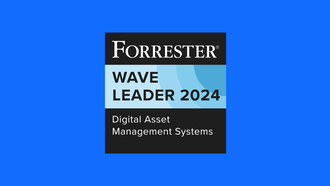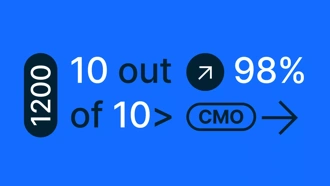Navigating the cloud storage landscape often leads to the crossroads of choosing between SharePoint vs. Dropbox. SharePoint is known for its robust features tailored for enterprise-level collaboration, emphasizing security and comprehensive content management. Dropbox is celebrated for its user-friendly approach, simplifying file-sharing and collaboration. The differences between SharePoint vs. Dropbox are pivotal, especially if you're looking for effective digital asset management. In this article, we'll unravel the unique strengths of each, guiding you toward a strategic choice for your content management and collaboration tools.
- SharePoint vs. Dropbox: Overview
- SharePoint vs. Dropbox: Deployment
- SharePoint vs. Dropbox: Security
- SharePoint vs. Dropbox: Integrations
- SharePoint vs. Dropbox: Functionality
- SharePoint vs. Dropbox: Pricing and storage
- Bynder: Top alternative to Dropbox and SharePoint
- Key takeaways: Dropbox vs. SharePoint
SharePoint vs. Dropbox: Overview
Choosing between Dropbox vs. SharePoint? Both have their strengths, and understanding the differences between SharePoint and Dropbox ensures you choose the right tool for your specific needs.
SharePoint and Dropbox are popular cloud-based platforms that simplify collaboration and streamline document management. While both cater to file storage, they differ in their approach. Dropbox provides seamless file syncing and sharing. It excels in simplicity, making it a go-to choice for personal and small business use.
SharePoint is an all-in-one content management suite, offering robust features for document versioning, workflow automation, and team collaboration. So, whether you want to manage your image collection or handle detailed brand templates, choose your digital ally wisely.
SharePoint vs. Dropbox: Deployment
Deploying SharePoint and Dropbox involves distinct processes. SharePoint, often integrated into the Microsoft 365 suite, is typically deployed within your organization's IT infrastructure. This deployment offers customization options for tailored solutions, making it ideal for large enterprises with complex collaboration needs, such as intricate media asset management. However, because of its complexity and the need for an IT professional, SharePoint might not be the best solution for those without the knowledge and skills needed to get this solution up and running.
Dropbox is celebrated for its user-friendly deployment. A simple sign-up and download give you immediate access. Its intuitive interface ensures a seamless user experience, allowing effortless file sharing and collaboration. Dropbox excels in simplicity, providing an accessible platform for those who prioritize ease of use over intricate customization.
SharePoint vs. Dropbox: Security
When it comes to security, SharePoint takes the lead with a comprehensive suite of robust features. SharePoint supports 2-factor authentication, adding an extra layer of protection to your accounts. It’s IRAP compliant and can encrypt files to safeguard sensitive data. Additionally, the platform enables password protection for files, protecting assets from unauthorized access.
Dropbox, while secure, falls short in certain aspects. It lacks document encryption, leaving potential vulnerabilities in data protection. Furthermore, if you want more robust security features, you have to purchase third-party integrations.
SharePoint vs. Dropbox: Integrations
SharePoint offers a seamless integration advantage, being an integral part of the Microsoft 365 ecosystem. You can easily collaborate with other Microsoft solutions like Word, Excel, and Azure. This creates a unified and familiar environment that streamlines workflows and enhances productivity. Additionally, SharePoint integrates with third-party tools like Salesforce, Zendesk, and various CRM and ERP systems. This flexibility ensures that SharePoint adapts to the unique needs of your organization, acting as a hub for streamlined operations, including cloud DAM.
Dropbox also offers an array of third-party integrations. Although it can integrate with SharePoint, the experience may not feel as cohesive as within the Microsoft 365 environment. Ultimately, choose the platform that aligns seamlessly with your existing software landscape and facilitates the smooth integration of essential tools.
SharePoint vs. Dropbox: Functionality
Dropbox excels in functionality with its user-friendly platform, offering an intuitive experience accessible to all users without the need for extensive technical skills. Its simplicity makes it a go-to choice for straightforward document storage. The interface is designed for efficiency, ensuring that you can navigate and utilize its features effortlessly, minimizing the learning curve.
SharePoint, while more complex, presents a powerhouse of functionality. Its versatility extends beyond document storage, encompassing collaboration, project management, and intricate content management. The flexibility tailors to your unique needs, creating a dynamic digital workspace. However, this richness in features demands a steeper learning curve, often requiring the assistance of IT support for optimal utilization.
SharePoint vs. Dropbox: Pricing and storage
Dropbox offers a free basic version with 2GB storage, making it an affordable option for individual users. For more robust storage, Dropbox provides "Plus" (2 TB at $9.99/month) and "Professional" (3 TB at $16.58/month) plans. Additionally, team-oriented solutions include "Standard" (5TB for the team at $15/user/month) and "Advanced" (15TB for the team at $24/user/month).
SharePoint offers two online versions. SharePoint Plan 1, at $5/user/month, is tailored for small-to-mid-sized businesses, providing 1 TB/user/month storage. This plan includes secure file sharing, real-time coauthoring, and access to OneDrive and Microsoft Lists.
The Microsoft 365 Business Standard, priced at $12.50/user/month, expands on Plan 1 by offering desktop, web, and mobile versions of Microsoft Office apps, business-class email, Microsoft Teams, and additional tools for personalized documents and video editing through Clipchamp.
Bynder: Top alternative to Dropbox and SharePoint
When it comes to digital asset management, Bynder emerges as a top competitor to Dropbox and SharePoint. Bynder goes beyond traditional asset storage, positioning itself as a comprehensive DAM solution with a suite of features that elevate brand management, streamline content creation, and provide unmatched scalability.
- Automating digital content creation: Bynder's templating and creative automation tools enable brands to create high-quality digital content quickly and get more content to market.
- Collaboration and workflow management: Bynder's Asset Workflow module helps brands streamline the review and approval of content from ideation to delivery.
- AI and automation: AI-powered search functionalities like "Search by Image"and "Similarity Search" enable marketers to discover the right assets for their campaigns or product in seconds.
- Integrated brand guidelines: The Brand Guidelines module available in the DAM enables brand managers to create an interactive digital home for all their guidelines to ensure brand consistency.
- Digital asset transformation: Bynder's DAT module handles asset transformations at scale, enabling brands to automatically generate images that are optimized for each channel, platform, or device.
Key takeaways: Dropbox vs. SharePoint
The choice between Dropbox and SharePoint ultimately depends on your preferences and your organization's requirements. While SharePoint might be the best choice for enterprise needs with 2-factor authentication, encryption, and Microsoft 365 integration, Dropbox excels in accessibility for individual users and small to medium-sized businesses.
As you compare SharePoint vs. Dropbox, also consider Bynder as a compelling alternative to these traditional solutions. With an extensive suite of features extending beyond basic asset storage, Bynder stands out as a comprehensive DAM solution. It proves to be not just an alternative but a proactive choice for your organization to elevate your digital content strategies and brand presence.












